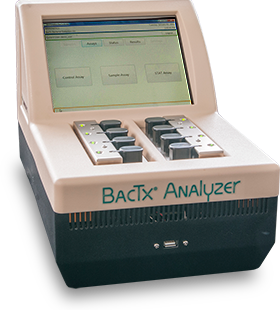
Can the BacTx Bacterial Contamination Assay be Useful for Cell Therapy Products?
Researchers evaluating a rapid assay for detection of bacterial contamination in platelets suggested that a point-of-release assay using the BacTx (Immunetics, Inc.) might give an additional level of safety for platelet transfusion recipients. The BacTx assay is a colorimetric, qualitative, QC test for the detection of aerobic and anaerobic, Gram-positive and Gram-negative bacteria and takes less than an hour to complete. Furthermore, a photometer accessory allows for testing of up to eight samples simultaneously and independently.
The BacTx works by detecting peptidoglycan, a universal component of the bacterial cell wall. The unit incorporates a binding protein that only reacts with the peptidoglycan initiating an enzymatic reaction. The reaction develops a red color that is automatically measured and reported by the BacTx Analyzer. The assay can be run in about 45 minutes, making it suitable to test platelet units shortly before they are transfused into a patient. It is the only platelet contamination test that combines universal bacterial detection with simple and easy workflow integration.
In 2013 the FDA approved the BacTx assay for bacterial testing of whole blood derived and apheresis platelets. The assay meets the AABB sensitivity recommendations for all clinically relevant bacterial strains. The only other FDA approved rapid point-of-use assay for bacterial detection of platelets is the Pan Genera Detection (PGD Test) cartridge (Verax Biomedical).
Spiking studies reported an assay sensitivity (LOQ) for ten different clinically relevant species with results ranging from 6.3 × 102 to as high as 7.6 × 104 CFU/mL. The table below shows sensitivity results for the spiked platelet samples with the lowest CFU/mL where 10 / 10 replicate samples were tested positive.
| Bacterial species | CFU/mL |
| Bacillus cereus (11778) | 1.3 × 103 |
| Clostridium perfringens (3629) | 9.4 × 102 |
| Escherichia coli (25922) | 5.1 × 103 |
| Klebsiella oxytoca (43863) | 6.8 × 103 |
| Propionibacterium acnes (11827) | 1.1 × 103 |
| Pseudomonas aeruginosa (27853) | 9.6 × 103 |
| Serratia marcescens (43862) | 4.2 × 103 |
| Staphylococcus aureus (27217) | 1.1 × 103 |
| Staphylococcus epidermidis (49134) | 6.3 × 102 |
| Streptococcus agalactiae (12386) | 3.3 × 103 |
Implications for Cellular Therapy
Although the Bactx was designed for rapid microbial detection in platelets, the technology may have potential for rapid microbial contamination testing of cell therapy products, particularly in-process samples such as pre-cell harvest. The targeting of peptidoglycan makes for an assay that may be highly specific for bacteria only without the complications of sample interference or false positives that most rapid methods present. With rapid assay test time (< 1 hour) and capability of eight independent tests running simultaneously the laboratory throughput does not appear to be limiting.
Of particular interest, this assay may be a good candidate to replace the oft used Gram stain assay. The Gram stain is commonly used as a rapid release test of cell products that have a short shelf-life where sterility tests, whether compendial 14-day or 7-day automated methods, are completed post-administration. In fact the FDA somatic cell therapy and aseptic processing guidance documents specifically reference the Gram stain as a rapid release test for cell therapies.
The main concern with the Gram stain is the lack of assay sensitivity. It has been reported in numerous studies as well as the ASM Clinical Manual that the Gram stain test is, at best, sensitive to a bacterial titer of about 105 CFU/mL. It also has been reported that platelet contamination with bacterial titers of more than 105 CFUs/mL have been associated with septic transfusion reactions, therefore an approximate 2- 3 log improvement in assay sensitivity should provide a greater level of patient infusion safety from short shelf-life cell products that utilize the Gram stain as a release test.
1. Jacobs MR, Good CE, Lazarus HM, et al. Relationship between bacterial load, species virulence, and transfusion reaction with transfusion of bacterially contaminated platelets. Clin Infect Dis 2008;46:1214-20.
Source: http://onlinelibrary.wiley.com/doi/10.1111/trf.12603/abstract
ABSTRACT
Background
Despite existing strategies, bacterial contamination of platelets (PLTs) remains a problem, and reliable testing near the time of use is needed. We evaluated the BacTx assay (Immunetics, Inc.), a rapid colorimetric assay for detection of bacterial peptidoglycan, for this purpose.
Study Design and Methods
Apheresis and whole blood–derived PLT units, the latter tested in 6-unit pools, inoculated with 10 representative bacterial species (eight aerobic, two anaerobic), were tested with the BacTx assay at two sites to determine analytic sensitivity and time to detection. Specificity on sterile PLTs and reproducibility across different PLT units and assay kit lots was also determined.
Results
Analytical sensitivity for the 10 bacterial species ranged from 6.3 × 102 to 7.6 × 104 colony-forming units (CFUs)/mL. In time-to-detection studies after inoculation of PLTs with 0.7 to 5.3 CFUs/mL, 10 replicates of all eight aerobic species were positive when bacterial titers were above the analytic sensitivity detection limit, which occurred at 48 hours for 60 PLT units and at 72 hours for the remaining 4 units, as well as at 7 days for all units. Specificity was 99.8% and reproducibility was 100%.
Conclusions
The BacTx assay had an analytical sensitivity below the 105 CFUs/mL threshold of clinical significance, detected all eight aerobic bacterial species 48 to 72 hours after inoculation as well as at 7 days, and had high specificity and reproducibility. These findings suggest that the BacTx assay will be a valuable test for detection of clinically relevant levels of bacterial contaminants in PLT units and pools near time of use.
